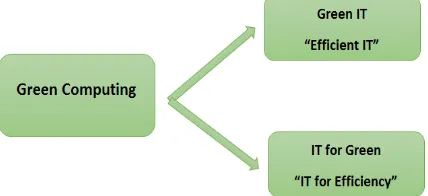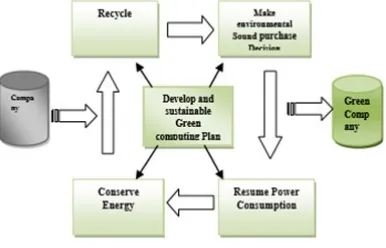A Study Based Analysis on Green Computing with Emergent
Technologies as Resource Platform
Dr. Swetha Margaret T A, Renuka Devi D
Asst. Professor, Department of Computer Science, Stella Maris College, Chennai, India
ABSTRACT
One of the emerging scenarios in computing technology is Green Computing. It is primarily concerned about the environmental based computing. Global warming is the critical issue to be addressed. This can be efficiently handled by means of efficient Green Computing Technology. The objective of Green computing is to attain economic viability and improve the way computing devices are used. Green IT practices include the development of environmentally sustainable production practices, energy-efficient computers and improved disposal and recycling procedures. This review paper outlines the fundamentals of green computing and its methods and analyses different Green strategies and current trends in green computing. In this paper, we account the consciousness en route for Green Computing and outline the key areas where IT organizations can achieve savings in terms of energy and cost.
Keywords : Green Computing, Global Warming, Computing Technology
I.
INTRODUCTION
In this decade, the most important environmental issue is to save our earth. Though there are so many different causes which are hampering the stability of nature, one of them is Global warming, Global warming is a serious issue today, and probably the most worrying threat to our planet is global warming. Green computing and the use of energy efficient green technologies can reduce this scaring impact of global warming, continuous use of non-recyclable energy resources can lead us to the dead end of the civilization.
The term -Green is strongly coupled with environment. So when we talk about -Green Computing, rather than strategies to build software products efficiently with minimum impact on environment. Developing a software product is not only bound to writing its core code, but also it includes several phases starting from planning to
maintenance. If we want to build energy efficient green software, we have to make the whole process -Green. The main reason for global warming is the emissions of carbon dioxide from desktops. In spite of that, there are several potential ways to solve these problems, or at least reduce their effects. The Green computing can also develop solutions that offer benefits by "aligning all IT processes and practices with the core principles of sustainability, which are to reduce, reuse, and recycle; and finding innovative ways to use IT in business processes to deliver sustainability benefits across the enterprise and beyond".
The goals of green computing are quite similar to green chemistry which are to reduce the use of hazardous materials, maximize energy efficiency during the product's lifetime, and promote the recyclability or biodegradability of non-operational products and factory waste [1].
Below figure 2 shows the framework of green computing
Figure 2. Framework of Green Computing
II.
LITERATURE SURVEY
Need of Green Computing:
In a world where business is transacted 24/7 across every possible channel available, companies need to collect, store, track and analyze enormous volumes of data—everything from click data and event logs to mobile call records and more. But this all comes with a cost to both businesses and the environment. Data warehouses and the sprawling data centers that house them use up a huge amount of power, both to run legions of servers and to cool them There are techniques that can be implemented to decrease the power consumption and impact on environment is termed as Green computing. Following are few techniques of Green Computing:
i) Reduce Energy Consumption:
―Around 30%-40% of computers are kept ON during the weekends and even after office hours and around 90% of these computers remain idle‖ by Environmental protection agency. If we develop any
application in green computing environment it will use optimal physical resources computing.
Figure 3. Fundamental Techniques of Green Computing
ii) E-waste recycling:
Electronic waste is shortly known as waste. E-waste recycling is the reprocessing and reusing of electrical and electronic equipment’s of any type that has been discarded. Some of the common E-wastes include: information technology equipment’s such as computers, mobile phones, laptops, batteries, circuit boards, hard disks, and monitors among others; and other electronic utilities such as leisure, lighting, and sporting equipment’s. Recycling of e-waste is a growing trend and was initiated to protect human and environmental health mainly due to the widespread environmental pollution impacts of e-waste.
iii) Reduce architectural complexity: The research area is open to reduce the number of tiers and component dependency to reduce maximum system use. Intel’s core 2 duo is a mechanism which uses power to run only those components which are necessary at any computation.
total facility power divided by IT equipment power. Thus, it is a measure of how much of the power being consumed by the facility is actually being used to power the IT equipment itself rather than all the other things. Therefore it will quiet be a challenge to make the bigger data center power efficient.
v) Developing Green Maturity Model: Full equipment life cycle is the main area for green maturity model, with energy reduction as the best measure of ―greenness. The need of maturity models for equipment, IT organizations, computing techniques is an issue which has been addressed by some researchers but is limited to specific areas. Green maturity model for virtualization depicts that each level describes the degree of green characteristics.
Steps to implement Green Computing
1. Develop a sustainable green computing plan. Discuss with the business leaders the elements that should be factored into such a plan, including organizational policies and checklists. Such a plan should include recycling policies, recommendations for disposal of used equipment, government guidelines and recommendations for purchasing green computer equipment. Green computing best practices and policies should cover power usage, reduction of paper Consumption, as well as recommendations for new equipment and recycling old machines. Organizational policies should include communication and implementation.
2. Discard used or unwanted electronic equipment in a convenient and environmentally responsible manner. Computers have toxin metals and pollutants that can emit harmful emissions into the environment. Never discard computers in a landfill. Recycle them instead through manufacturer programs such as HP's Planet Partners recycling service or recycling facilities in your community. Or donate still-working computers to a non-profit agency.
3. Make environmentally sound purchase decisions. Purchase Electronic Product Environmental Assessment Tool registered products.
4. If we think computers are nonpolluting and consume very little energy we need to think again. It is estimated that out of $250 billion per year spent on powering computers worldwide only about 15% of that power is spent.
5. Computing- the rest is wasted idling. Thus, energy saved on computer hardware and computing will equate tons of carbon emissions saved per year. 6. The plan towards green IT should include new electronic products and services with optimum efficiency and all possible options towards energy savings.
7. Power supplies are notoriously bad, generally as little as 7% efficient. And since everything in a computer runs off the power supply, nothing can be efficient without a good power supply. Recent inventions of power supply are helping fix this by running at 80% efficiency or better.
8. Mobile phones are better than computers – green computing. They have faster processors, more ram, faster.
9. Wireless Internet connectivity and larger memories. Mobile Phones consume very low power. 10. Purchase LCD‗s monitors which consume less energy than CRT‗s screen and LCD‗s is also not harmful for the eyes.
ii. Fit-PC: a tiny PC that draws only 5w: Fit-PC is the size of a paperback and absolutely silent, yet fit enough to run Windows XP or Linux. Fit-PC is designed to fit where a standard PC is too bulky, noisy and power hungry. If you ever wished for a PC to be compact, quiet and green then fit- PC is the perfect fit for you. Fit-PC draws only5 Watts, consuming in a day less power than a traditional PC consumes in 1 hour. You can leave fit-PC to work 24/7 without making a dent in your electric bill.
Merits and Demerits of Green Computing: Reduced energy usage from green computing techniques translates into lower carbon dioxide emissions, stemming from a reduction in the fossil fuel used in power plants and transportation.
Conserving resources means less energy is required to produce, use, and dispose of products.
Saving energy and resources saves money.
Green computing even includes changing government policy to encourage recycling and lowering energy use by individuals and businesses.
Reduce the risk existing in the laptops such as chemical known to cause cancer, nerve damage and immune reactions in humans.
Demerits:
Green computing could actually be quite costly.
Some computers that are green may be considerably underpowered.
Rapid technology change
III.
CONCLUSION AND FUTURE SCOPE
Green computing represents a responsible way to address the issue of global warming. To make the computer society completely green, one should do the following things. When computer components are not in our use then the components must be donated to those people who may not have those components. Instead of discarding computers,
upgrade their parts in order to make them new. As predominantly black and fonts are of gray color. This arrangement consumes very less energy. So, Go green is a concept which is used in few organizations but if everyone use its components then it could be beneficial for everyone. The benefits of green computing are clear. Hence proper implementation of Green computing will be helping hand in terms to save energy and remove the pollution.
IV.
REFERENCES
[1].Biswajit Saha, " Green Computing" in International Journal of Computer Trends and Technology (IJCTT), volume 14 , Aug 2014,pp. 46-50.
[2].Pushtikant Malviya, Shailendra Singh, " A Study about Green Computing" in International Journal of Advanced Research in Computer Science and Software Engineering, volume 3,Issue 6,June 2013,pp. 790-794.
[3].Gaurav Jindal, Manisha Gupta, "Green Computing, Future of Computers" in International Journal of Emerging Research in Management &Technology, December 2012, pp. 14-18.
[4].Tariq Rahim Soomro and Muhammad Sarwar, "Green Computing: From Current to Future Trends" in International Scholarly and Scientific Research & Innovation, Vol:6, March 2012,pp. 455-458.
[6].Application of Green computing in Framing Energy Efficient Software Engineering, Aritra Mitra, Riya Basu, Avik Guha, Shalabh Agarwal,Asoke Nath, International Journal of Advanced Computer Research, Vol-3, No.1, Issue- 3(march),pp. 117-121(2013).
[7].A Comprehensive study on Cloud Green Computing : To Reduce Carbon Footprints Using Clouds,Chiranjeeb Roy Chowdhury, Arindam Chatterjee, Alap Sardar, Shalabh Agarwal, Asoke Nath, International Journal of Advanced Computer Research, Vol-3, No.1, Issue-3(march),pp. 78-85(2013).
[8].A Study on implementing Green IT in Enterprise 2.0, Shalabh Agarwal, Asoke Nath, International Journal of Advanced Computer Research, Vol-3, No.1, Issue-3(march),pp. 43-49(2013).

